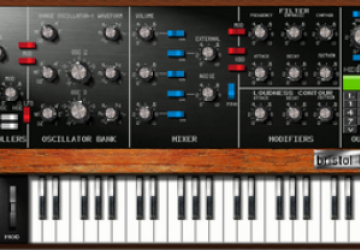News In The Linux Audio World

There's always something noteworthy happening in Linux audio development. This week's news includes reports about a new Linux audio blog, music made by particle acceleration, how to use a laptop as a virtual music stand, synth emulation from the terminal command prompt, and watching the Linux Audio Conference on-line.
Louigi's Blog
Composer Louigi Verona (a.k.a. Kirill Alferov) has been focused on making music with what he calls an Integrated Modular Environment (IME) - what some of us might call a monolithic application - and is an especially persuasive advocate for the excellent LMMS music software. His Web site includes an article in which he voices his concern over the lack of IMEs for Linux, but more recently he has experimented with a more typically modular approach to his Linux-based music-making and has written a good up-to-date profile of two software packages previously reviewed here, the Rakarrack effects processor and the Phasex synthesizer. Check out Louigi's Linux blog and be sure to listen to some of his music. If the developers of LMMS want to convince someone to use their software they could do no better than to promote Louigi's LMMS-based compositions. Seriously, they are some of the best demonstrations of that program's possibilities that I've heard yet.

LHCsound
You never know what might turn up on the Csound mail list. A few days ago composer/developer Richard Dobson posted an interesting message regarding LHCsound, a project that intends to sonify the results from the operation of the Large Hadron Collider (LHC), the famous particle accelerator at CERN. The site already includes sonifications by various researchers, and they actively encourage participation from other users interested in the sonic potential in the data generated by the accelerator. Sonification, in case you don't already know, is the process of converting non-audio data to some form of audio output. The process can be applied to city skylines, mountain range profiles, stellar maps, and virtually anything else that can produce a relatively large and varied set of data. As might be expected, the raw musical results of such processes are debatable, but the process itself is another valuable utility in the contemporary composer's toolkit.

VirtMus
If you're a notation-literate musician who needs to read sheet music you might be interested in Gabriel Burca's VirtMus (Figure 3), a unique "modern music stand". Basically VirtMus works with scanned scores to provide the reader with a "hands-off" experience. Reading musicians know the irritation of turning pages during a performance, and some methods have already been devised to ameliorate the situation. Alas, most of those solutions employ custom hardware systems that replace the normal music stand with an electronic score "presenter", i.e. a view-screen that scrolls the music during its performance. VirtMus is similar in intent but quite different in its solution to the problem. All you need for it is a laptop computer and a PDF file of your score. The VirtMus Web page notes that you can use a scanner or digital camera to create a PDF file readable by the program. Once your score is in electronic form you can use VirtMus to annotate and highlight passages that need special attention. Page turns are made by mouse or keyboard, but for completely hands-free operation a USB foot switch is recommended.

Alas, development of VirtMus appears to be stalled. The concept is cool - an affordable alternative to dedicated digital music displays - and the source code is freely availably, so there's hope for the project's revival. And if any of my readers happen to step up to the challenge, please let me know. I'd be happy to update the status of the VirtMus project.
The Naked Synth
On April 4 developer Nick Copeland announced version 0.50.5 of his Bristol synthesizer (Figure 2) on the Linux Audio Users mail list. Bristol emulates a variety of classic analog and digital synthesizers, with a unique GUI for each emulation. The synth's colorful interface is handled in a separate thread by a custom graphics toolkit called Brighton, thus opening the possibility of a GUI-less Bristol. On April 8 composer Julien Claassen asked Nick about a command-line interface for Bristol, and that question launched a discussion that quickly became better suited to the Linux Audio Developers list. On that list, Julien posted a message with the subject Interface development for the blind (starting from Bristol), and the discussion that followed helped Nick create the first command-line interface (CLI) for Bristol, four days after Julien's original enquiry.

Bravo to Nick and Julien for their work on this feature. I was impressed by Julien's articulation of the issues facing developers of CLIs for blind and visually impaired users, and I was equally impressed by Nick's willingness to devote his time and energies to delivering a prototype. Incidentally, I mentioned that the first version of Bristol with its CLI option appeared circa the 0.50.x release. According to Nick's News page the latest version is already in the 0.60 release series, with updated code for the CLI. Nicely done, gentlemen, very nicely done.
LAC 2010
The Linux Audio Conference will be held in Utrecht from May 1 through May4. If you can't make the show you can still peruse the scheduled presentations, read the abstracts there, and then choose which presentations you'd like to watch from the video stream from StackingDwarves enabled once again by the indefatigable Jörn Nettingsmeier. I reviewed some of the papers for this year's conference, they were all very good, and I plan to tune in to watch some of the presentations. Last year's Theora-encoded audio/video feed was superb, I'm looking forward to being a virtual attendee once again.
Outro
I hope you've enjoyed this brief report. I'll return soon with a series dedicated to some very cool Linux software for algorithmic music composition. Until then, stay tuned and rock on.










